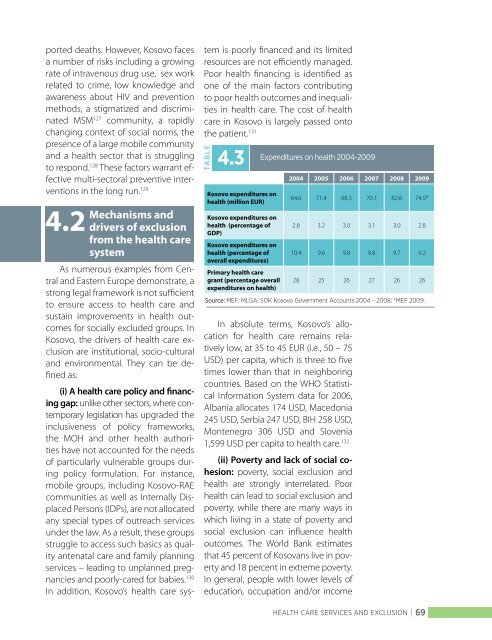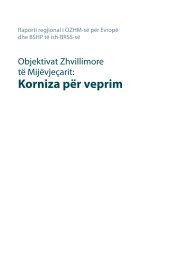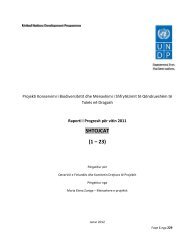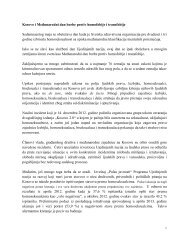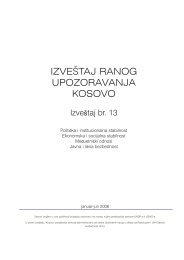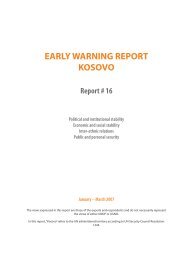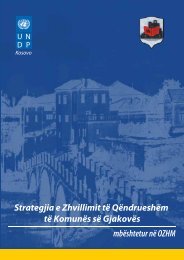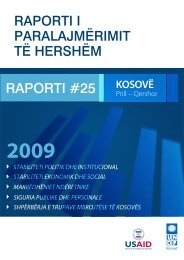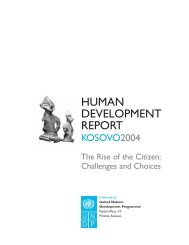Kosovo Human Development Report 2010 - UNDP Kosovo - United ...
Kosovo Human Development Report 2010 - UNDP Kosovo - United ...
Kosovo Human Development Report 2010 - UNDP Kosovo - United ...
You also want an ePaper? Increase the reach of your titles
YUMPU automatically turns print PDFs into web optimized ePapers that Google loves.
ported deaths. However, <strong>Kosovo</strong> faces<br />
a number of risks including a growing<br />
rate of intravenous drug use, sex work<br />
related to crime, low knowledge and<br />
awareness about HIV and prevention<br />
methods, a stigmatized and discriminated<br />
MSM 127 community, a rapidly<br />
changing context of social norms, the<br />
presence of a large mobile community<br />
and a health sector that is struggling<br />
to respond. 128 These factors warrant effective<br />
multi-sectoral preventive interventions<br />
in the long run. 129<br />
4.2<br />
Mechanisms and<br />
drivers of exclusion<br />
from the health care<br />
system<br />
As numerous examples from Central<br />
and Eastern Europe demonstrate, a<br />
strong legal framework is not sufficient<br />
to ensure access to health care and<br />
sustain improvements in health outcomes<br />
for socially excluded groups. In<br />
<strong>Kosovo</strong>, the drivers of health care exclusion<br />
are institutional, socio-cultural<br />
and environmental. They can be defined<br />
as:<br />
(i) A health care policy and financing<br />
gap: unlike other sectors, where contemporary<br />
legislation has upgraded the<br />
inclusiveness of policy frameworks,<br />
the MOH and other health authorities<br />
have not accounted for the needs<br />
of particularly vulnerable groups during<br />
policy formulation. For instance,<br />
mobile groups, including <strong>Kosovo</strong>-RAE<br />
communities as well as Internally Displaced<br />
Persons (IDPs), are not allocated<br />
any special types of outreach services<br />
under the law. As a result, these groups<br />
struggle to access such basics as quality<br />
antenatal care and family planning<br />
services – leading to unplanned pregnancies<br />
and poorly-cared for babies. 130<br />
In addition, <strong>Kosovo</strong>’s health care sys-<br />
tem is poorly financed and its limited<br />
resources are not efficiently managed.<br />
Poor health financing is identified as<br />
one of the main factors contributing<br />
to poor health outcomes and inequalities<br />
in health care. The cost of health<br />
care in <strong>Kosovo</strong> is largely passed onto<br />
the patient. 131<br />
Table<br />
4.3<br />
<strong>Kosovo</strong> expenditures on<br />
health (million EUR)<br />
<strong>Kosovo</strong> expenditures on<br />
health (percentage of<br />
GDP)<br />
<strong>Kosovo</strong> expenditures on<br />
health (percentage of<br />
overall expenditures)<br />
Primary health care<br />
grant (percentage overall<br />
expenditures on health)<br />
Expenditures on health 2004-2009<br />
Source: MEF; MLGA, SOK <strong>Kosovo</strong> Government Accounts 2004 – 2008; *MEF 2009.<br />
In absolute terms, <strong>Kosovo</strong>’s allocation<br />
for health care remains relatively<br />
low, at 35 to 45 EUR (i.e., 50 – 75<br />
USD) per capita, which is three to five<br />
times lower than that in neighboring<br />
countries. Based on the WHO Statistical<br />
Information System data for 2006,<br />
Albania allocates 174 USD, Macedonia<br />
245 USD, Serbia 247 USD, BIH 258 USD,<br />
Montenegro 306 USD and Slovenia<br />
1,599 USD per capita to health care. 132<br />
(ii) Poverty and lack of social cohesion:<br />
poverty, social exclusion and<br />
health are strongly interrelated. Poor<br />
health can lead to social exclusion and<br />
poverty, while there are many ways in<br />
which living in a state of poverty and<br />
social exclusion can influence health<br />
outcomes. The World Bank estimates<br />
that 45 percent of Kosovans live in poverty<br />
and 18 percent in extreme poverty.<br />
In general, people with lower levels of<br />
education, occupation and/or income<br />
2004 2005 2006 2007 2008 2009<br />
64.6 71.4 68.3 70.1 62.6 74.5*<br />
2.8 3.2 3.0 3.1 3.0 2.8<br />
10.4 9.6 9.8 9.8 9.7 9.2<br />
28 25 26 27 26 26<br />
HEALTH CARE SERVICES AND EXCLUSION<br />
| 69


